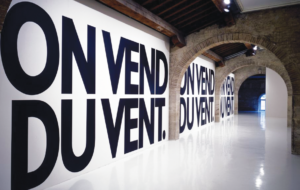
Advertising and art are inextricably linked. Today, every color, logo and slogan in the world is thoughtfully planned out as market research groups gauge consumer response to minute variations in product presentation.
While this type of fine-tuned artistry may seem ubiquitous, in reality it is the product of the 1980s, when art fused with advertising and artists became brands.
“Brand New: Art and Commodity in the 1980s,” the newest exhibit at the Hirshhorn Museum and Sculpture Garden, presents nearly 150 works that catalog this transformation. Running from Feb. 14 to May 13, “Brand New” documents the rise of counterculture art in New York City and presents viewers with the subversive, ironic and brilliant artwork that has led to the creation of the contemporary artistic language seen today.
At a press preview for the exhibit’s opening, curator-at-large Gianni Jetzer quoted Walt Disney, “Here you leave today and enter the world of yesterday, tomorrow and fantasy.” Jetzer continued to say, “This is kind of the motto of the show.”
He gestured at the artwork and walked through the rooms of the exhibit, explaining “Brand New” as a meditation on the material world of the 1980s.
“Commodity isn’t the product, but rather the message,” Jetzer said. As advertising became more artistic, it communicated more effectively with viewers and began to dictate – and then satisfy – their needs.
“Brand New,” named for the prevalence of brands in the 1980s, presents work from nearly 70 American and European artists. Although all the work is impressive, several pieces pack a particularly hard punch, including the large photographic silkscreen-on-vinyl piece by Barbara Kruger that reads, “I shop therefore I am.”
“It’s very ambivalent. It makes you question if it’s true,” Jetzer said of the quote.
Kruger’s piece lends itself to another central theme of the show: linking objects to messages. In the 1980s, everything became “brand new.” As art and advertising merged, innumerable combinations of messages were created.
The art featured in this exhibit spans a broad range; colorful paintings hang near vacuum cleaners, and dye-transfer bottles sit in cases near intricate sculptures. The intermingling of manufactured objects with larger, more complex artistic creations demonstrates the powerful role even small objects had in making art a commodity.
A standout piece in the exhibit is a self-portrait by Andy Warhol, who is widely known for his iconic self-branding. Ironically, the piece hangs on a wall plastered with wallpaper made by an artist who called himself “Not Warhol.”
“Tormented Self-Portrait” by Ashley Bickerton, a large black case hanging from the wall that is plastered with colorful brand names, is particularly fascinating because it is partly inspired by the self-portraits of Van Gogh. This “self-portrait” presents the notion that human beings are an aggregation of the products they use. Brands featured on her piece include the Metro symbol and a cigarette brand, logos that allude to aspects of Bickerton’s identity.
In conjunction with the debut of “Brand New,” the Hirshhorn is offering a variety of free public programs that allow visitors to further explore the exhibit’s message.
Yesterday afternoon, the museum hosted a walk-in curator’s tour of “Brand New,” and on March 9 at 12:30 p.m. it will host a gallery experience in which the Hirshhorn librarian will present rare archives to attendees.
On March 30 at 12:30 p.m. there will be a tour of “Brand New” focusing on the role of women, and on April 27 at 12:30 p.m. artist Peter Nagy, whose art is featured in “Brand New,” will lead a tour through the exhibit and give viewers insight into his experiences as an artist.
“Brand New” is a colorful, thought-provoking exploration of the artistic transition of the 1980s that conflates art, commerce and entertainment to produce the advertising we see today.
During the tour, Jetzer cited a 1988 piece by Haim Steinbach that covers the walls outside the exhibit’s opening. In large black letters, the piece reads, “ON VEND DU VENT,” or, “we sell wind,” a phrase that encapsulates the message of the show.
“You can’t feel the wind, but it has power,” Jetzer said. Although advertising may not always be at the forefront of our minds, its cultural impact is powerful .
“Brand New” is available for viewing at the Hirshhorn Museum as of Feb. 14. The museum is located at Independence Ave. SW & 7th St. SW. Admission is free.



















